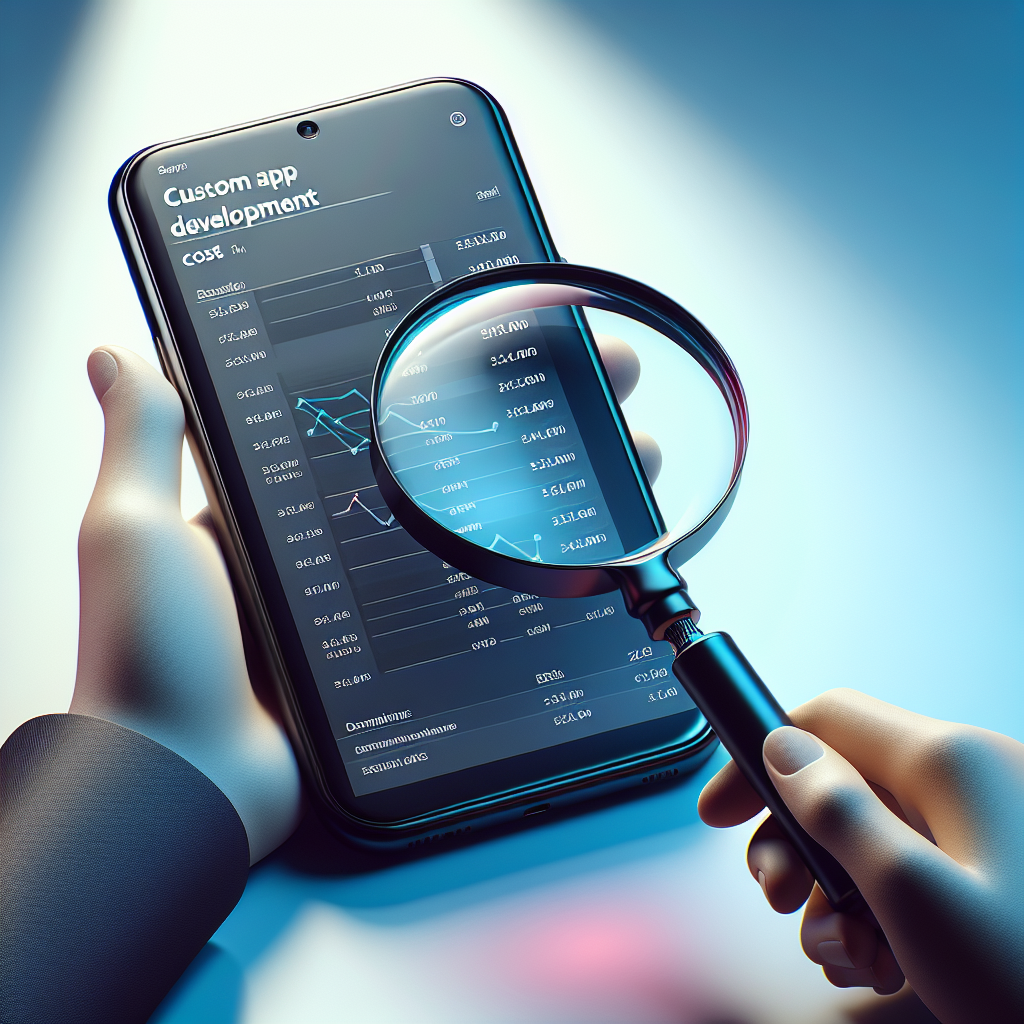Custom Mobile Apps Prices: What You Need to Know
Diving into the realm of custom mobile app development often brings up the critical question: How much will it cost? Understanding the factors that influence custom mobile apps prices is essential before embarking on your development journey. These prices can vary significantly based on a multitude of elements, from the complexity of the app’s features to the choice of development platforms.
In this article, we will explore the various factors that affect the cost of developing a custom mobile app, helping you make informed decisions. Whether you’re a startup with a groundbreaking idea or an established business looking to enhance customer engagement, knowing the cost implications can guide your strategy and budget planning.
To get an accurate estimate tailored to your unique requirements, get a free quote from our experienced team at NS804. We are experts in native mobile app development and can provide you with a detailed cost analysis.
Factors Influencing App Development Costs

When it comes to determining custom mobile apps prices, several key factors play a significant role. Understanding these elements can help you better estimate your project’s budget and manage expectations.
- App Complexity: The more complex an app is, the higher the development cost. Complexity can be influenced by features such as user authentication, integration with third-party services, and advanced functionalities like augmented reality.
- Platform Choice: Developing an app for a single platform (iOS or Android) is generally less expensive than creating a cross-platform solution. Each platform requires different coding languages and expertise, which can add to the overall cost.
- Design Requirements: A well-designed user interface (UI) and user experience (UX) are crucial for app success. High-quality design demands more time and resources, thus increasing costs.
- Backend Development: If your app requires a robust backend to manage data, user accounts, or real-time updates, this will add to the development cost. Backend complexity varies based on the type of data and the number of users the app must support.
- Testing and Quality Assurance: Rigorous testing is essential to ensure your app functions smoothly across different devices and operating systems. This process can be time-consuming and costly but is necessary for delivering a reliable product.
- Post-Launch Support: Ongoing maintenance, updates, and technical support are vital aspects that contribute to the overall cost of app development. These services ensure that your app remains functional and relevant in a constantly evolving market.
By considering these factors, you can gain a clearer understanding of what drives app development costs and how to budget effectively for your project.
Stages of Mobile App Development
The journey of creating a custom mobile app is divided into several crucial stages, each contributing to the final product and impacting the overall custom mobile apps prices. Here’s a breakdown of the key stages involved:
- Idea and Conceptualization: This initial phase involves brainstorming and defining the core idea of the app. It’s essential to identify the target audience, understand their needs, and outline the app’s primary features. This stage often includes market research and feasibility studies.
- Planning and Strategy: Once the concept is clear, the next step is to develop a comprehensive project plan. This includes setting timelines, defining the scope, and allocating resources. A well-structured plan acts as a roadmap for the development process.
- Design: The design phase focuses on creating an intuitive and engaging user interface (UI) and user experience (UX). Wireframes and prototypes are developed to visualize the app’s layout and functionality. This stage is critical for ensuring that the app is user-friendly and visually appealing.
- Development: This is where the actual coding and programming happen. Developers work on building the app’s frontend and backend, integrating necessary features, and ensuring the app functions as intended. This phase is often the most time-consuming and resource-intensive.
- Testing: Quality assurance (QA) is a vital stage that involves rigorous testing to identify and fix bugs or issues. Testing ensures that the app performs well across different devices and operating systems, providing a seamless user experience.
- Deployment: Once testing is complete, the app is ready for launch. This stage involves submitting the app to app stores (such as Google Play and Apple App Store) and making it available for users to download.
- Post-Launch Support and Maintenance: The development process doesn’t end with deployment. Ongoing support, regular updates, and maintenance are crucial to keep the app running smoothly and to adapt to user feedback or changes in the market.
Each of these stages is integral to the successful development of a mobile app and collectively influences the overall cost and timeline of the project.
Ongoing Maintenance and Support Costs

After the initial launch of your custom mobile app, the journey doesn’t end. In fact, ongoing maintenance and support are crucial for the longevity and success of your app. These post-launch activities are essential to ensure that your app remains functional, secure, and competitive in the ever-evolving mobile landscape. Here’s what you need to know about the ongoing maintenance and support costs:
- Bug Fixes and Updates: No app is perfect from the start. Post-launch, you’ll likely need to address unforeseen bugs and issues that users encounter. Regular updates are also necessary to improve features, enhance performance, and maintain compatibility with the latest versions of operating systems.
- Security Updates: Cybersecurity is a growing concern, and mobile apps are no exception. Regular security updates are essential to protect your app and its users from vulnerabilities and threats. This often involves patching security loopholes and adhering to new security standards.
- Server and Infrastructure Costs: If your app relies on backend servers and cloud services, you’ll incur ongoing costs for server maintenance, data storage, and bandwidth. These costs can vary depending on your app’s usage and data requirements.
- Performance Monitoring: Continuous monitoring of your app’s performance is crucial to identify and resolve any issues promptly. This includes tracking metrics such as load times, crash reports, and user engagement to ensure a smooth user experience.
- User Support: Providing excellent customer support is vital for user satisfaction and retention. This can involve setting up a helpdesk, responding to user queries, and resolving technical issues.
- Feature Enhancements: To stay relevant and competitive, you may need to add new features or improve existing ones based on user feedback and market trends. This requires an ongoing investment in development and design.
These ongoing activities are essential to keep your app relevant and ensure a positive user experience. While they do incur additional costs, they are a worthwhile investment to maintain your app’s quality and competitiveness in the market.
Cost Comparison: Custom vs. Off-the-Shelf Apps

When deciding to develop a mobile app, one of the critical decisions you’ll face is whether to opt for a custom app or an off-the-shelf solution. Each option comes with its own set of advantages and costs, which can significantly impact your decision-making process. Here, we compare the costs associated with custom mobile apps and off-the-shelf apps:
- Initial Development Costs: Custom apps are tailored to meet your specific requirements, which means the initial development costs are generally higher. This includes the costs for designing, coding, testing, and deploying a unique solution. On the other hand, off-the-shelf apps are pre-built solutions available at a lower upfront cost because the development is spread across multiple users.
- Customization and Flexibility: Custom apps offer unparalleled flexibility and can be designed to fit your exact needs, which can be a significant advantage if you have unique business processes or require specific features. However, off-the-shelf apps come with limited customization options, and any modifications can incur additional costs or may not be feasible at all.
- Ongoing Costs: While the initial investment in a custom app is higher, the ongoing costs can be more predictable. Custom apps can be maintained and updated as per your business needs, without relying on third-party schedules. Off-the-shelf apps often come with subscription fees, licensing costs, and potential upgrade fees, which can add up over time.
- Integration Capabilities: Custom apps can be designed to seamlessly integrate with your existing systems and software, ensuring a smooth workflow and data consistency. Off-the-shelf apps might not offer the same level of integration, leading to potential inefficiencies and additional costs for workarounds or third-party integrations.
- Scalability: Custom apps are built with your business growth in mind, allowing for easy scalability as your user base or feature requirements expand. Off-the-shelf solutions may have limitations in terms of scalability, and outgrowing the app could necessitate a costly switch to a custom solution later on.
- Support and Updates: Custom app developers typically offer dedicated support and are more responsive to your specific needs. Off-the-shelf apps rely on generic support channels, which might not address your issues promptly. Moreover, updates for off-the-shelf apps are controlled by the provider and may not align with your business timeline.
In summary, while off-the-shelf apps may seem cost-effective initially, custom mobile apps offer long-term value, flexibility, and scalability that can better align with your business goals. Understanding these differences can help you make an informed decision that balances cost and functionality.
How to Budget for a Custom Mobile App

Budgeting for a custom mobile app can be a daunting task, but with careful planning and an understanding of the key cost factors, you can create a realistic budget that aligns with your business objectives. Here are some steps to help you budget effectively for a custom mobile app:
- Define Your Requirements: Start by clearly defining the features and functionalities you need. Create a detailed project scope document that outlines your app’s objectives, target audience, essential features, and any specific technologies you plan to use. This will help you communicate your vision to potential developers and get accurate cost estimates.
- Research and Choose Developers: Look for experienced custom mobile app development companies, like NS804, who have a proven track record of delivering high-quality apps. Request quotes from multiple developers to compare pricing, but remember that the lowest quote may not always be the best option. Consider the developer’s expertise, portfolio, and client reviews.
- Consider Design Costs: The design phase is crucial for creating an intuitive and engaging user experience. Budget for UI/UX design, including wireframing, prototyping, and visual design. High-quality design can enhance user satisfaction and retention, which can translate into better ROI.
- Factor in Development Costs: Development costs will vary based on the complexity of your app, the platforms you want to target (iOS, Android, or both), and the technologies used. Ensure that your budget includes costs for front-end and back-end development, API integrations, and third-party services if needed.
- Allocate for Testing and QA: Rigorous testing is essential to ensure your app functions smoothly and is free of bugs. Allocate a portion of your budget for quality assurance (QA) testing, including functional, performance, and security testing.
- Plan for Deployment and Maintenance: Budget for app store submission fees, ongoing maintenance, and updates. Post-launch support is crucial for fixing issues, improving features, and ensuring compatibility with new OS versions.
- Include Marketing and Promotion: Building a great app is only half the battle; you also need to attract users. Allocate funds for marketing and promotional activities, such as social media campaigns, app store optimization (ASO), and paid advertising.
By following these steps, you can create a comprehensive budget that covers all aspects of custom mobile app development. Remember, investing in a custom app is an investment in your business’s future success. If you need expert guidance or a detailed quote, get a free quote from NS804 today and take the first step towards bringing your vision to life.
























